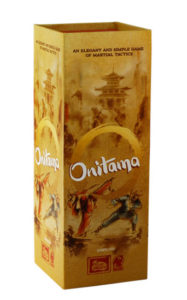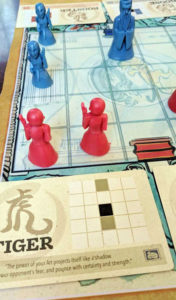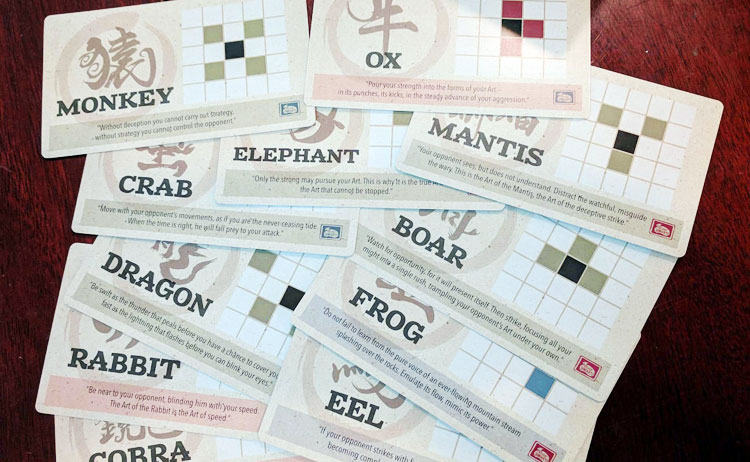 Masters of the Schools of Martial Arts travel to Onitama with their most promising disciples to prove their superiority in battle. Will you win via the aggressive Way of Stone, or the Zen Way of the Stream? Elegant and simple to learn, Onitama is a quick strategy game with open information that plays like chess but varies from game to game. Lots of depth and a short play time will keep you pulling this one off the shelf, but not just as filler or a time killer.
Masters of the Schools of Martial Arts travel to Onitama with their most promising disciples to prove their superiority in battle. Will you win via the aggressive Way of Stone, or the Zen Way of the Stream? Elegant and simple to learn, Onitama is a quick strategy game with open information that plays like chess but varies from game to game. Lots of depth and a short play time will keep you pulling this one off the shelf, but not just as filler or a time killer.
Onitama is a two player abstract strategy game that takes about ten minutes to play.
Gameplay Overview:

Onitama opens with two lines of pieces – four students and one master – facing each other on a 5×5 grid. Five movement cards are dealt out. The object is to either get your master token from your Temple Arch space to your opponent’s (Way of the Stream), or to capture your opponent’s master (Way of Stone).
Capturing is accomplished by moving one piece onto another. Movements are done by using one of the movement cards. Used movement cards are passed to your opponent, thus each player will have opportunities to use all five moves.
The depth in Onitama comes from your ability to think multiple moves ahead as well as anticipate what your opponent is doing. Additionally, the small grid prevents any long stretches of chase to the inevitable end (which can sometimes be an issue in games like chess).
The only thing I considered potentially problematic with the movement cards is that there is a possibility (very small, but still there) of drawing a set of cards that do not allow for a certain movement (say, diagonal, or backwards) which could seriously hamper play.

Game Experience:
It all started with the letter O – or rather, a quest to find a solid game that started with the letter O for my Alphabet board game challenge. A friend offered to bring her copy of Onitama to our next game night, and I figured a quick play would get me off the hook for what proved to be one of the more challenging letters to get checked off. The entire explanation of the rules lasted about three mins, a great departure from some of our “be sure to watch this 45 minute video before we start to go over the 30 page rule book” type games.
I was concerned that it might be too fast, or just a little too easy to be challenging (which for me is the fun benchmark). By about halfway through our first game I was bent over the board, brow furrowed, blocking out every other noise in the room in order to focus on where I was moving next, what card to relinquish, and plotting every one of her possible moves in my head and fingers. I pulled out my phone and ordered a copy as soon as we finished.

The next day, I read the rulebook, which is extremely well written. It has handy pictorial guides to illustrate the major rules and no major redundancies that bog down or confuse someone picking it up for the first time. Once again the full explanation was complete in under five minutes and we were up and playing.
This play through was with someone I teach regularly, and it occurred to me that Onitama would be an excellent tool for teaching new and young players “move and capture” type of games. Additionally, it makes a great, quick substitution for other games of that type that might have too long a playtime.
The impressionist feel of the art and pieces is beautiful and adds to the elegant, Zen-like feel of the game. While I admire the precision that went into the box’s organization, I’m not in love with the box itself. It’s really easy to open it incorrectly, spilling components hither and yon. The roll up mat for the board is brilliant however, no folded game board here that needs to be anchored in order to lay flat.
Final Thoughts:
Onitama is a beautiful, quick abstract game with enough depth to be challenging without dedicating an entire afternoon to learning the rules or game play. The rulebook is concise and well organized, making this an easy game for even someone unfamiliar with it to pick up and play in minutes. The movement cards add variability to each game, though on the (rare) occasion may cause the game to stall. Overall, Onitama is an exceedingly well designed game and a must-play for anyone that likes abstract strategy games
Final Score: 4.5 Stars – Quick, elegant abstract strategy with variety between games makes this a winner.
 Hits:
Hits:
• Well-designed rulebook
• Variation between game plays
• Challenging but not over-long
Misses:
• Box can be confusing to open
• Potential bad card draw might leave players with less than optimal moves























If you end up with a stalled situation, why not just shuffle the cards back into the deck and start over
Cause that’s not the rules of the game 🙂
Even if the cards in a particular game are not optimal, you can still exchange pawns and try to get a better position in order to win.
I’ve played games with only diagonals, and I’ve also played games with no diagonals at all, and they have still been fun to play.